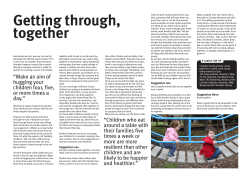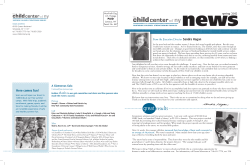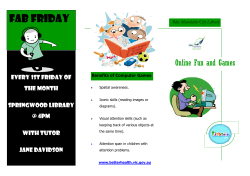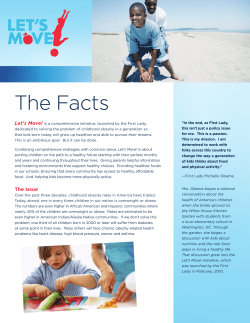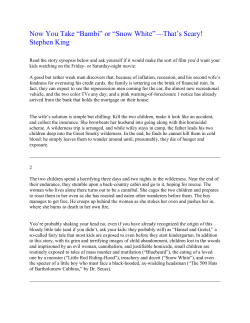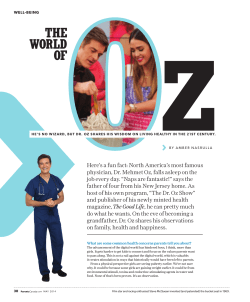
T How to Bring Our Schools
DECEMBER 18, 2006
s o c i e t y
How to
Bring Our
Schools
Out of the
20th Century
{ By CLAUDIA WALLIS and SONJA STEPTOE }
here’s a dark little joke exchanged by educators with
a dissident streak: Rip Van Winkle awakens in the 21st century after a hundred-year snooze and is, of course, utterly bewildered by what he sees. Men and women dash about, talking
to small metal devices pinned to their ears. Young people sit at
home on sofas, moving miniature athletes around on electronic screens. Older folk defy death and disability with metronomes in
their chests and with hips made of metal and plastic. Airports, hospitals,
shopping malls—every place Rip goes just baffles him. But when he
finally walks into a schoolroom, the old man knows exactly where he is.
“This is a school,” he declares. “We used to have these back in 1906. Only
now the blackboards are green.”
T
Reprinted through the courtesy of the Editors of Time Magazine © 2005 Time Inc.
s o c i e t y
American schools aren’t exactly frozen in
time, but considering the pace of change in
other areas of life, our public schools tend to
feel like throwbacks. Kids spend much of
the day as their great-grandparents once did:
sitting in rows, listening to teachers lecture,
scribbling notes by hand, reading from textbooks that are out of date by the time they are
printed. A yawning chasm (with an emphasis on yawning) separates the world inside
the schoolhouse from the world outside.
For the past five years, the national conversation on education has focused on reading scores, math tests and closing the
“achievement gap” between social classes.
This is not a story about that conversation.
This is a story about the big public conversation the nation is not having about education, the one that will ultimately determine
not merely whether some fraction of our
children get “left behind” but also whether
an entire generation of kids will fail to make
the grade in the global economy because
they can’t think their way through abstract
problems, work in teams, distinguish good
information from bad or speak a language
other than English.
This week the conversation will burst
onto the front page, when the New Commission on the Skills of the American Workforce,
a high-powered, bipartisan assembly of Education Secretaries and business, government and other education leaders releases
a blueprint for rethinking American education from pre-K to 12 and beyond to better
prepare students to thrive in the global economy. While that report includes some controversial proposals, there is nonetheless a
remarkable consensus among educators and
business and policy leaders on one key conclusion: we need to bring what we teach
and how we teach into the 21st century.
Right now we’re aiming too low. Competency in reading and math—the focus of
so much No Child Left Behind (nclb) testing—is the meager minimum. Scientific and
technical skills are, likewise, utterly necessary but insufficient. Today’s economy demands not only a high-level competence in
the traditional academic disciplines but
also what might be called 21st century
skills. Here’s what they are:
Knowing more about the world. Kids are
global citizens now, even in small-town
America, and they must learn to act that
way. Mike Eskew, ceo of UPS, talks about
needing workers who are “global trade literate, sensitive to foreign cultures, conversant in different languages”—not exactly
strong points in the U.S., where fewer than
half of high school students are enrolled in
Becoming smarter about new sources of
information. In an age of overflowing infor-
KIDS NEED TO LEARN HOW
TO LEAP ACROSS
DISCIPLINES BECAUSE THAT
IS HOW BREAKTHROUGHS
NOW COME ABOUT. IT’S
INTERDISCIPLINARY
COMBINATIONS—DESIGN
AND TECHNOLOGY,
MATHEMATICS AND ART—
THAT PRODUCE YOUTUBE
AND MYSPACE
a foreign-language class and where the social-studies curriculum tends to fixate on
U.S. history.
Thinking outside the box. Jobs in the new
economy—the ones that won’t get outsourced or automated—“put an enormous
premium on creative and innovative skills,
seeing patterns where other people see only
chaos,” says Marc Tucker, an author of the
skills-commission report and president of
the National Center on Education and the
Economy. Traditionally that’s been an
American strength, but schools have become
less daring in the back-to-basics climate of
nclb. Kids also must learn to think across
disciplines, since that’s where most new
breakthroughs are made. It’s interdisciplinary combinations—design and technology,
mathematics and art—“that produce YouTube and Google,” says Thomas Friedman,
the best-selling author of The World Is Flat.
TIME, DECEMBER 18, 2006
mation and proliferating media, kids need to
rapidly process what’s coming at them and
distinguish between what’s reliable and
what isn’t. “It’s important that students know
how to manage it, interpret it, validate it, and
how to act on it,” says Dell executive Karen
Bruett, who serves on the board of the
Partnership for 21st Century Skills, a group
of corporate and education leaders focused
on upgrading American education.
Developing good people skills. EQ, or
emotional intelligence, is as important as IQ
for success in today’s workplace. “Most innovations today involve large teams of people,”
says former Lockheed Martin ceo Norman
Augustine. “We have to emphasize communication skills, the ability to work in teams
and with people from different cultures.”
Can our public schools, originally designed to educate workers for agrarian life
and industrial-age factories, make the necessary shifts? The skills commission will argue that it’s possible only if we add new
depth and rigor to our curriculum and standardized exams, redeploy the dollars we
spend on education, reshape the teaching
force and reorganize who runs the schools.
But without waiting for such a revolution,
enterprising administrators around the
country have begun to update their schools,
often with ideas and support from local
businesses. The state of Michigan, conceding that it can no longer count on the ailing
auto industry to absorb its poorly educated
and low-skilled workers, is retooling its
high schools, instituting what are among
the most rigorous graduation requirements
in the nation. Elsewhere, organizations like
the Bill and Melinda Gates Foundation, the
Carnegie Foundation for the Advancement
of Teaching and the Asia Society are pouring money and expertise into model programs to show the way.
What It Means to Be a Global Student
Quick! How many ways can you combine
nickels, dimes and pennies to get 20¢?
That’s the challenge for students in a
second-grade math class at Seattle’s John
Stanford International School, and hands
are flying up with answers. The students
sit at tables of four manipulating play money. One boy shouts “10 plus 10”; a girl offers
“10 plus 5 plus 5,” only it sounds like this:
“Ju, tasu, go, tasu, go.” Down the hall, thirdgraders are learning to interpret charts and
graphs showing how many hours of sleep
people need at different ages. “¿Cuantas
s o c i e t y
horas duerme un bebé?” asks the teacher
Sabrina Storlie.
This public elementary school has taken
the idea of global education and run with it.
All students take some classes in either
Japanese or Spanish. Other subjects are
taught in English, but the content has an international flavor. The school pulls its 393
students from the surrounding highly diverse neighborhood and by lottery from
other parts of the city. Generally, its scores
on state tests are at or above average, although those exams barely scratch the surface of what Stanford students learn.
Before opening the school seven years
ago, principal Karen Kodama surveyed 1,500
business leaders on which languages to
teach (plans for Mandarin were dropped for
lack of classroom space) and which skills
and disciplines. “No. 1 was technology,” she
recalls. Even first-graders at Stanford begin to use PowerPoint and Internet tools.
“Exposure to world cultures was also an
important trait cited by the executives,” says
Kodama, so that instead of circling back to
the Pilgrims and Indians every autumn, children at Stanford do social-studies units on
Asia, Africa, Australia, Mexico and South
America. Students actively apply the lessons
in foreign language and culture by videoconferencing with sister schools in Japan,
Africa and Mexico, by exchanging messages, gifts and joining in charity projects.
Stanford International shows what’s
possible for a public elementary school, although it has the rare advantage of support
from corporations like Nintendo and Starbucks, which contribute to its $1.7 million-ayear budget. Still, dozens of U.S. school
districts have found ways to orient some of
their students toward the global economy.
Many have opened schools that offer the international baccalaureate (I.B.) program, a
rigorous, off-the-shelf curriculum recognized by universities around the world and
first introduced in 1968—well before globalization became a buzzword.
To earn an I.B. diploma, students must
prove written and spoken proficiency in
a second language, write a 4,000-word
college-level research paper, complete a
real-world service project and pass rigorous
oral and written subject exams. Courses
offer an international perspective, so even a
lesson on the American Revolution will
interweave sources from Britain and France
with views from the Founding Fathers. “We
try to build something we call international
mindedness,” says Jeffrey Beard, director
general of the International Baccalaureate
Organization in Geneva, Switzerland. “These
are students who can grasp issues across national borders. They have an understanding
of nuances and complexity and a balanced
approach to problem solving.” Despite stringent certification requirements, I.B. schools
are growing in the U.S.—from about 350 in
2000 to 682 today. The U.S. Department of
Education has a pilot effort to bring the program to more low-income students.
Real Knowledge in the Google Era
Learn the names of all the rivers in South
America. That was the assignment given
to Deborah Stipek’s daughter Meredith in
school, and her mom, who’s dean of the
Stanford University School of Education,
was not impressed. “That’s silly,” Stipek
told her daughter. “Tell your teacher that
if you need to know anything besides
the Amazon, you can look it up on Google.”
Any number of old-school assignments—
memorizing the battles of the Civil War or
the periodic table of the elements—now
seem faintly absurd. That kind of information, which is poorly retained unless you
routinely use it, is available at a keystroke.
Still, few would argue that an American
child shouldn’t learn the causes of the Civil
War or understand how the periodic table
reflects the atomic structure and properties of the elements. As school critic E.D.
Hirsch Jr. points out in his book, The
Knowledge Deficit, kids need a substantial
fund of information just to make sense of
reading materials beyond the grade-school
level. Without mastering the fundamental
building blocks of math, science or history,
complex concepts are impossible.
Many analysts believe that to achieve
the right balance between such core knowledge and what educators call “portable
skills”—critical thinking, making connections between ideas and knowing how to
keep on learning—the U.S. curriculum
needs to become more like that of Singapore,
Belgium and Sweden, whose students outperform American students on math and science tests. Classes in these countries dwell
on key concepts that are taught in depth and
in careful sequence, as opposed to a succession of forgettable details so often served in
U.S. classrooms. Textbooks and tests support
this approach. “Countries from Germany to
Singapore have extremely small textbooks
that focus on the most powerful and generative ideas,” says Roy Pea, co-director of the
TIME, DECEMBER 18, 2006
IN THIS MEDIA-DRENCHED
ERA OF BLOGS AND
PODCASTS, GOOGLE
SEARCHES AND INSTANT
MESSAGES, YOUNG PEOPLE
NEED TO ACQUIRE A NEW
SET OF LITERACY SKILLS
THAT ALLOWS THEM TO
LOCATE INFORMATION, SORT
THROUGH IT QUICKLY AND,
MOST IMPORTANT,
DETERMINE WHICH SOURCES
ARE RELIABLE AND WHICH
ONES AREN’T
Stanford Center for Innovations in Learning.
These might be the key theorems in math,
the laws of thermodynamics in science or the
relationship between supply and demand in
economics. America’s bloated textbooks, by
contrast, tend to gallop through a mindnumbing stream of topics and subtopics in
an attempt to address a vast range of state
standards.
Depth over breadth and the ability to
leap across disciplines are exactly what
teachers aim for at the Henry Ford Academy,
a public charter school in Dearborn, Mich.
This fall, 10th-graders in Charles Dershimer’s
science class began a project that combines
concepts from earth science, chemistry,
business and design. After reading about
Nike’s efforts to develop a more environmentally friendly sneaker, students had to
s o c i e t y
choose a consumer product, analyze and
explain its environmental impact and then
develop a plan for re-engineering it to reduce
pollution costs without sacrificing its commercial appeal. Says Dershimer: “It’s a challenge for them and for me.”
A New Kind of Literacy
The juniors in Bill Stroud’s class are riveted
by a documentary called Loose Change unspooling on a small TV screen at the
Baccalaureate School for Global Education,
in urban Astoria, N.Y. The film uses 9/11
footage and interviews with building engineers and Twin Towers survivors to make an
oddly compelling if paranoid case that interior explosions unrelated to the impact of
the airplanes brought down the World
Trade Center on that fateful day. Afterward,
the students—an ethnic mix of New Yorkers
with their own 9/11 memories—dive into a
discussion about the elusive nature of truth.
Raya Harris finds the video more convincing than the official version of the facts.
Marisa Reichel objects. “Because of a
movie, you are going to change your beliefs?” she demands. “Just because people
heard explosions doesn’t mean there were
explosions. You can say you feel the room
spinning, but it isn’t.” This kind of discussion about what we know and how we
know it is typical of a theory of knowledge
class, a required element for an international-baccalaureate diploma. Stroud has
posed this question to his class on the
blackboard: “If truth is difficult to prove in
history, does it follow that all versions are
equally acceptable?”
Throughout the year, the class will examine news reports, websites, propaganda,
history books, blogs, even pop songs. The
goal is to teach kids to be discerning consumers of information and to research, formulate and defend their own views, says
Stroud, who is founder and principal of the
four-year-old public school, which is located in a repurposed handbag factory.
Classes like this, which teach key aspects
of information literacy, remain rare in public education, but more and more universities and employers say they are needed as
the world grows ever more deluged with
information of variable quality. Last year, in
response to demand from colleges, the
Educational Testing Service unveiled a new,
computer-based exam designed to measure
information-and-communication-technology literacy. A pilot study of the test with 6,200
high school seniors and college freshmen
found that only half could correctly judge the
objectivity of a website. “Kids tend to go to
Google and cut and paste a research report
together,” says Terry Egan, who led the team
that developed the new test. “We kind of
assumed this generation was so comfortable
with technology that they know how to use
it for research and deeper thinking,” says
Egan. “But if they’re not taught these skills,
they don’t necessarily pick them up.”
Learning 2.0
The chairman of Sun Microsystems was up
against one of the most vexing challenges of
modern life: a third-grade science project.
Scott McNealy had spent hours searching
the Web for a lively explanation of electricity that his son could understand. “Finally I
found a very nice, animated, educational
website showing electrons zooming around
and tests after each section. We did this for
about an hour and a half and had a ball—a
great father-son moment of learning. All of
a sudden we ran out of runway because it
was a site to help welders, and it then got into welding.” For McNealy the experience,
three years ago, provided one of life’s aha!
moments: “It made me wonder why there
isn’t a website where I can just go and have
anything I want to learn, K to 12, online,
browser based and free.”
His solution: draw on the Wikipedia
model to create a collection of online courses
that can be updated, improved, vetted and
built upon by innovative teachers, who, he
notes, “are always developing new materials
and methods of instruction because they
aren’t happy with what they have.” And who
better to create such a site than McNealy,
whose company has led the way in designing open-source computer software? He
quickly raised some money, created a nonprofit and—voilà!—Curriki.org made its
debut January 2006, and has been growing
fast. Some 450 courses are in the works,
and about 3,000 people have joined as members. McNealy reports that a teenager in
Kuwait has already completed the introductory physics and calculus classes in 18 days.
Curriki, however, isn’t meant to replace
going to school but to supplement it and
offer courses that may not be available locally. It aims to give teachers classroom-tested
content materials and assessments that are
livelier and more current and multimediabased than printed textbooks. Ultimately, it
could take the Web 2.0 revolution to school,
TIME, DECEMBER 18, 2006
closing that yawning gap between how kids
learn at school and how they do everything
else. Educators around the country and
overseas are already discussing ways to certify Curriki’s online course work for credit.
Some states are creating their own online courses. “In the 21st century, the ability
to be a lifelong learner will, for many people,
be dependent on their ability to access and
benefit from online learning,” says Michael
Flanagan, Michigan’s superintendent of
public instruction, which is why Michigan’s
new high school graduation requirements,
which roll out next year, include completing
at least one course online.
A Dose of Reality
Teachers need not fear that they will be
made obsolete. They will, however, feel increasing pressure to bring their methods—
along with the curriculum—into line with
the way the modern world works. That
means putting a greater emphasis on teaching kids to collaborate and solve problems in
small groups and apply what they’ve learned
in the real world. Besides, research shows
that kids learn better that way than with the
old chalk-and-talk approach.
At suburban Farmington High in
Michigan, the engineering-technology
department functions like an engineering firm, with teachers as project managers, a Ford Motor Co. engineer as a
consultant and students working in
teams. The principles of calculus,
physics, chemistry and engineering are
taught through activities that fill the
hallways with a cacophony of nailing,
sawing and chattering. The result: the
kids learn to apply academic principles
to the real world, think strategically and
solve problems.
Such lessons also teach students to show
respect for others as well as to be punctual,
responsible and work well in teams. Those
skills were badly missing in recently hired
high school graduates, according to a survey
of over 400 human-resource professionals
conducted by the Partnership for 21st Century Skills. “Kids don’t know how to shake
your hand at graduation,” says Rudolph
Crew, superintendent of the Miami-Dade
school system. Deportment, he notes, used
to be on the report card. Some of the nation’s
more forward-thinking schools are bringing
it back. It’s one part of 21st century education that sleepy old Rip would recognize.
—With reporting by Carolina A. Miranda
© Copyright 2025
